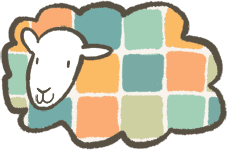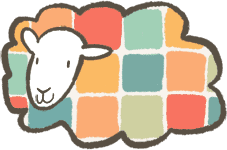








Taming, Training and Making Friends with your Sheep!
Tips on taming & making friends, halter training and looking at things from a sheep's point of view!
Based on over 10 years experience of keeping sheep and spending a lot of time observing and getting to know my own flock.
Scroll down to find some handy tips for making friends with your sheep!
Useful tips for making friends with sheep
Work in a small area!
 In the beginning its best to work in a very small area. Either inside or in a small pen in the field. This forces the issue more and gives the sheep less options to ignore you and run away. They have to get used to you being near them this way.
In the beginning its best to work in a very small area. Either inside or in a small pen in the field. This forces the issue more and gives the sheep less options to ignore you and run away. They have to get used to you being near them this way.
Get on their level!
 Crouch, kneel, even sit down with them. You will find your sheep much more relaxed and willing to come up to you when you get on their level. Don’t stand up until they are relaxed with you.
Crouch, kneel, even sit down with them. You will find your sheep much more relaxed and willing to come up to you when you get on their level. Don’t stand up until they are relaxed with you.
Fuss, scratches and cuddles!
 Sheep just love being scratched. Start on their chin, neck and between their front legs and once they are more confident some will accept having their backs and bellies scratched. They will approach you and stand for hours to be scratched and cuddled.
Sheep just love being scratched. Start on their chin, neck and between their front legs and once they are more confident some will accept having their backs and bellies scratched. They will approach you and stand for hours to be scratched and cuddled.
Food!
 It works for many sheep, but not all. Try to feed them by hand, they will soon be more relaxed approaching you and whilst they are eating you can begin to stroke and touch them. They should soon get more used to contact with you.
It works for many sheep, but not all. Try to feed them by hand, they will soon be more relaxed approaching you and whilst they are eating you can begin to stroke and touch them. They should soon get more used to contact with you.
No sudden movements!
 Make sure in the beginning you move slowly with clear intent and are gentle. Don’t grab or chase after them if they move away. Sheep are flight animals and spook easily.
Make sure in the beginning you move slowly with clear intent and are gentle. Don’t grab or chase after them if they move away. Sheep are flight animals and spook easily.
Time, repetition and patience!
 Spend time with them everyday, keeping the same routine and they will quickly learn your intentions and begin to enjoy your company. Sheep are all different and some take a lot more time and patience than others but don’t ever give up.
Spend time with them everyday, keeping the same routine and they will quickly learn your intentions and begin to enjoy your company. Sheep are all different and some take a lot more time and patience than others but don’t ever give up.
Your sheep will get to know you specifically and may be wary of strangers.
Sheep have great memories and they recognize individual faces, like a dog would.
My sheep and lambs are used to people, mostly to me and whilst some individuals have bags of confidence towards strange people, others are much more shy and wary.
If I go and sit in the field with the intention of fussing the sheep they know it by my body language and they will gather round me on all sides shoving each other out of the way to get close to me for attention, scratches and cuddles. Once you start scratching their weak spots their faces go all droopy and they stand there half asleep, I’m sure some would stand there all day if I would sit there! Sometimes if its a nice warm day they will sit with you and just chill out. Sometimes if you stop scratching them and ignore them they will start pawing and gently shoving you asking for more attention. Its an amazing calming experience to spend time with them like this.
But they aren’t all like this with everybody, they know me and my face and my intentions at the time. If I go in the field intending to gather them in for say feet trimming, they know it and are much more wary. Likewise if I bring strangers into the field the sheep can be very cautious and a lot more jumpy, though not always. This is down to the fact my sheep see me at least once everyday, we like in a pretty quiet and remote area, we don’t have public footpaths or roads bordering any of our fields so my sheep see minimal people for much of the year except me and my family. But usually given a few minutes and some friendly food they will relax a lot, especially the lambs, they are just way too curious and love to check everything out!
To have tame friendly sheep you need to spend time with them on a regular basis, they more time you give them the more confident and relaxed they will be. But don’t worry, even if you stop spending so much time with them, maybe due work or a holiday they won’t forget that you are a nice person to be around and you can always win them back.
If you buy sheep or lambs from us here they will be very used to interaction from people but you will also need to do your bit to win them over to you once you get them home. Sometimes it just takes a few days for them to settle in and relax around you, sometimes weeks and sometimes especially with aloof adult sheep it can take months for them to accept you.
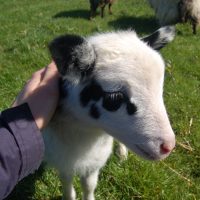
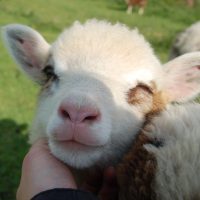
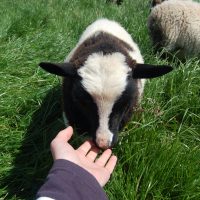
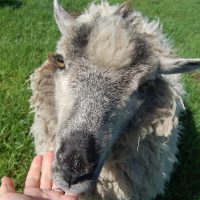
Food and Halter Training
Buying a sheep's affection!
As mentioned above food is a great way of winning sheep over!
Its no surprise that food can be the key to their heart, it works with most animals so why not sheep. Feed them daily or twice daily a small amount and they will soon get used to you and realise you ain’t so bad!
- Call them and rattle a bucket full of sheep nuts when you feed them and they will quickly learn and come to call, you will then be able to call them over in the field and use a bucket of nuts to get them in for feet trimming or shearing for example.
- Feed them by hand as much as possible and if you put feed in a trough or buckets stay with them whilst they eat and perhaps even have a fussing and scratching session with them after they have finished eating.
- If they won’t eat from your hand let them eat out of a bucket you are holding and keep offering food by hand, if they won’t do this place the food in a bucket on the ground but stay with them and get them to associate you with food. They gradually progress to a held bucket then hand feeding.
- For some sheep their natural flight instinct will override their desire to eat but you can over come this by putting them is a smaller enclosure and spending a lot of time with them.
Halter Training
It can be a way of getting a sheep used to human contact or it might be something you want to teach your already tame friendly pet sheep.
If your sheep is not approachable you will need to confine them to a very small pen to get things started and restrain them whilst you fit the halter. If they are friendly enough to be approached and have a halter fitted you can work in a bigger area.
You can purchase specific sheep rope halters these are universal and will fit all sizes and shapes of heads. You can also purchase specific webbing halters for sheep and calves (they usually fit too) they can be more pricey and harder to come by. If you can’t get a halter you could try with a collar instead but a halter will give you much more control over your sheep and is a better training aid.
The first time a sheep wears a halter they will usually jump around in protest but they will accept a halter with regular training sessions. If your sheep is very friendly, calm and docile you may even find they accept a halter first time, with the encouragement of food of course!
Tips and Techniques for Halter Training:
- Gently fasten the halter on your sheep. If you can approach them with food and the halter and introduce it with food association, gradually. You can pop the halter near their head and offer food, gradually working up to popping the halter on them and rewarding with food. If he/she is too nervous to approach you can either take a step back and work on approaching them with food and getting them more accepting of you or you can carry on and restrain them whilst you fit the halter, rewarding with food once it is on.
- Keep the lead short. Don’t allow a nervous sheep a lot of lead as them may panic and rush about in the beginning. Keeping a short lead gives you more control.
- Have a pocket full of sheep nuts. Offer food by hand, only when they are standing still, don’t ask anything on the halter yet just hold them on a short lead and offer food, thus you are associating the halter with a good thing. If you sheep enjoys a fuss and scratch now is a good time to do this too. And if you sheep is very nervous it can also be a good approach to gently stroke them and get them used to contact from you on the halter, they may be nervous at first.
- Reward any good behavior! So in the beginning, standing still, not jumping about, pulling back or trying to get away from you is good behavior and warrants some sheep nuts. Some nervous sheep will really panic when haltered for the first time so you will need to be calm and patient with them and let them accept contact from you.
- Halter training is all about Pressure and Release! To start with you will teach you sheep to give in to light pressure when you gently pull the rope towards you. If they give in to the pressure and start to take a step in the right direction you reward them with a release of pressure on the rope and you can give them some some feed too. You can use feed to encourage them in the right direction whilst applying gentle pressure too. Some sheep will instantly fight or panic when pressure is applied, they may pull backwards, leap about, rush in erratic directions and even throw themselves to the ground. If this happens don’t worry, keep relaxed and keep a gentle pressure on the rope until you get a step, or even a hint of a step in the right direction and reward with a release.
- Try holding your hand out with food or rattling a bucket. Get someone to help you do that if you can’t manage to hold the sheep and bucket at the same time. Encourage them forwards and to move along with you and keep rewarding them being near you and giving in to pressure with a release of pressure and some food.
- Try sitting down next to them and stroking them. Get them used to human touch. Scratch and fuss them, cuddle them if the enjoy it, make the whole experience good for them, even if they are a bit nervous, sometimes its best to just not be nervous yourself, of making them nervous and just throw them in at the deep end and ignore any leaping about or nervous looks you get. Eventually the sheep will realise you aren’t doing anything harmful to them and start to enjoy their halter training sessions.
- Teach them to tie. Once your sheep is relaxed and happy on a halter, understands pressure and release, you will be able tie them up. This can be especially useful for things like a shearing stand or applying medication.
If you can accomplish all the above they you will have a nicely halter trained sheep! You will be able to take him or her for walks or perhaps go to a show! You can use the halter anytime you are handling your sheep or moving to a new field. Your sheep should of learnt to respect the halter and you. You may find you still need to pen him/her in to fit the halter, sheep are clever and may anticipate what you have planned for them!
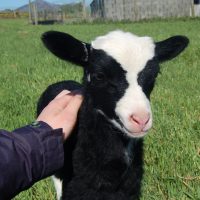
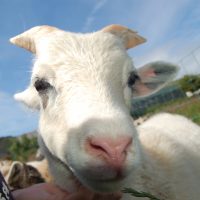
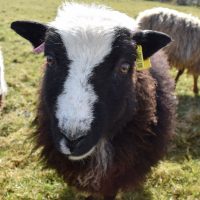
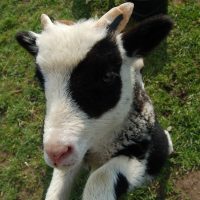
Your sheep's point of view
It's important to think like a Sheep too!
Some things to keep in mind:
- Sheep are prey animals. They have a Fight, Flight or Freeze instinct wired into them! No matter how tame they become they may still act on instinct if panicked. Try not to think like a predator, and see things from their perspective.
- They don’t like sudden movements. Prey animals don’t, it usually makes them jump and run in response. If one sheep spooks, they often all will, its instinct. If you are trying to catch them, and start chasing them you will cause more panic. Move slowly, its more effective, and herd them into a smaller area where you can handle them calmly.
- They understand body language. It talks to them, more than vocally, sheep communicate with body language. Just like horses, they can understand your intentions from subtle body language and movement, you probably won’t even be aware what you are communicating to them. So its important to always be clear in your thoughts what your intentions are, this will impact on your body language and posture, if you are calm it will communicate to the sheep.
- Not every sheep is the same. They all have very different personalities! Just like people, some are over confident and full of themselves, some are very inquisitive and natural born leaders, others shy and gentle and get pushed around and some just don’t want to know you and keep to themselves. So don’t expect the same results from every sheep, accept their different personalities and work with them.
- Age. Young sheep are easier to tame from scratch and sometimes more inquisitive but they are naturally much more jumpy, nervous and flighty. They lack experience, like a new puppy would, having been taken away from mum they have to get used to a whole new bunch of things. They may not have had their feet trimmed before or had a halter on or been sheared. They won’t have years of experience of human handling like an older sheep would. Confidence comes with time and experiences, so make sure they are positive. Having said all that an older sheep who has hardly been handled will present you with much more of a challenge than a lamb would!
- They need company. Our sheep are born into a flock and grow up with other lambs and adult sheep around them. They move and think as a flock and don’t have to make decisions for themselves, they follow and feed off each other. They gain confidence this way, or with the wrong company they can learn fear. Sheep are much happier being kept in groups of 3 or more, they naturally feel more relaxed being in a group, the bigger the group the more secure they are likely to feel. If you isolate just 1 from the group they will naturally feel more nervous and fearful as they lack that security, so bear this in mind.
So when working with your sheep and trying to make friends remember to think like a sheep too and try to work around problems from their point of view, don’t get frustrated or angry if its not going to plan, just take a step back and re-think.

